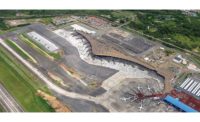Calgary Airport Expansion Scope Increases
After months of wrangling between the Calgary Airport Authority and the city of Calgary, the airport's $2-billion expansion has received a last-minute add-on: a tunnel underneath the 14,000-ft-long, 200-ft-wide runway.
The $1.4 billion terminal is already in construction and substantial work recently started on the $620 million runway—the largest project of its kind in North America.
The two entities reached a tentative agreement in May, allowing the city to construct a six-lane extension of Airport Trail east under the runway to connect to the northeast section of the city, also keeping open the possibility for future light rail extension.
Jim Stevenson, Calgary Alderman, says the road represents a vital east-west connector. “The situation is right now we don’t need it, there is nothing but gophers on the east side of the airport,” he says. But projected growth has the city adding 85,000 residents and 40,000 workers there in the next 20 years. “If we don’t build it now, we won’t be able to build.”
The city also promised another $50 million on top of the project’s projected $295 million price tag to construct two new overpasses near the airport, but won’t fully extend Airport Trail now or add the overpasses until funding is available. The city also takes on liability for the tunnel and pays for any delays it causes the runway project. Stevenson says he expects the tunnel to come in substantially under budget, hopefully defraying some of the extra $50 million.
Not all members of the City Council agreed with the decision to move forward in a 9-6 vote. Those against the project say the high cost and potential liability run too high. But Calgary Mayor Nasheed Nenshi says doing this now keeps vital light rail options open for the future.
As the city and airport iron out a sublease agreement, Peter Rudolf, the airport’s runway program director, says he first thought the project could delay his May 2014 opening by six months. But now runway contractor PPD Joint Venture Alberta-based PCL, Pasadena-based Parsons Corp. and Ontario-based Dufferin) says they should stay on schedule, even with the added tunnel.
Work on the two projects—the city has chosen PCL to be its lead contractor as well—will happen concurrently. “Our schedule takes precedence, but if all works out, nobody will be delayed,” Rudolf says. “Potentially it could work out quite well.”
The runway design needs only minimal changes. The tunnel box lies under the northern third of the runway and at the project’s high point, easing stormwater drainage design modifications. Instead of working a straight north-to-south route, however, the contractor will leave a 100-meter gap and need to return once the tunnel box is covered. “It is disruptive in terms of flow and sequencing, but design-wise it is a convenient change,” Rudolf says. “It will take a bit of discussion between the design teams.”
With a final agreement expected this week, work on the tunnel will start within days, Stevenson says.
Along with the airport’s fourth runway comes an aircraft parking apron, taxiways, a central deicing facility and the airport may also add a new fire hall and maintenance facility to house all snow-clearing equipment. In all, crews will move 264 million cubic ft. of dirt in the project.
Navigation Canada, under the direction of the airport, also plans to erect a 300-ft.-tall control tower—the tallest in Canada—by November 2012.
To accommodate the expected increase to more than 27 million passengers by 2025, the airport has started its 1.9-million-sq-ft, five-story International Facilities Project (East Concourse), the largest expansion in airport history.
Constructed by Ontario-based EllisDon Corp., the new 22 aircraft gates will serve international visitors and boast a high-performance building envelope, complete with rainwater harvesting, co-generation facilities and 600 geothermal wells for in-floor radiant heating. The terminal will open October 2015.



